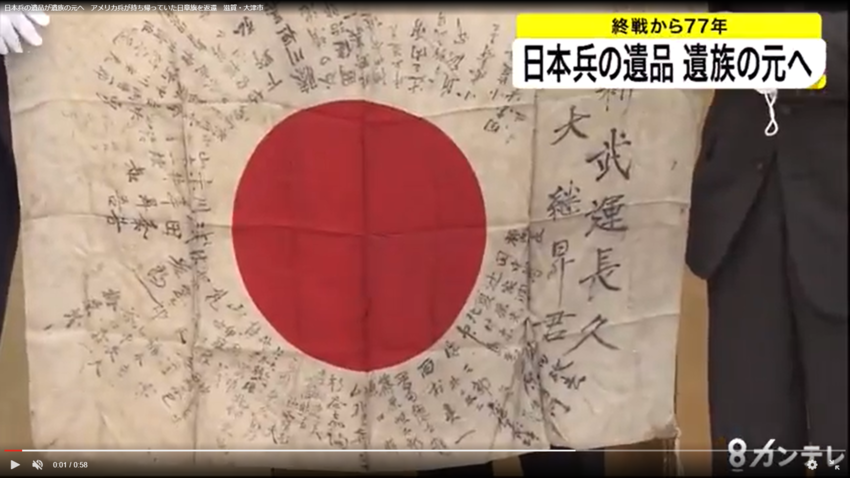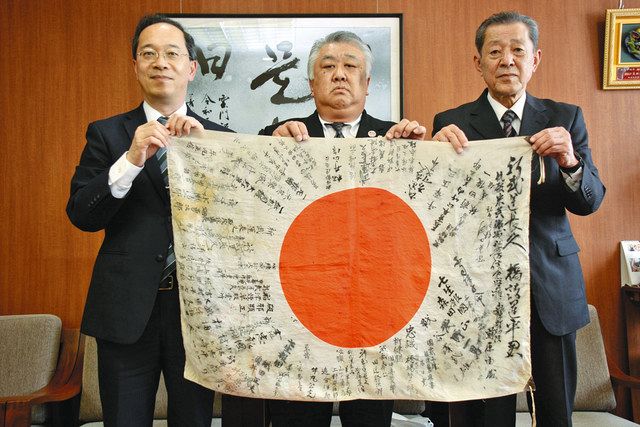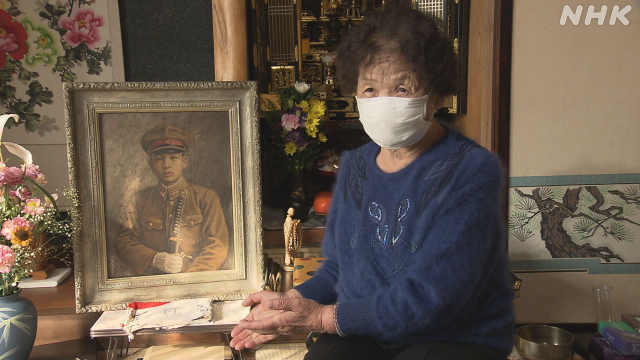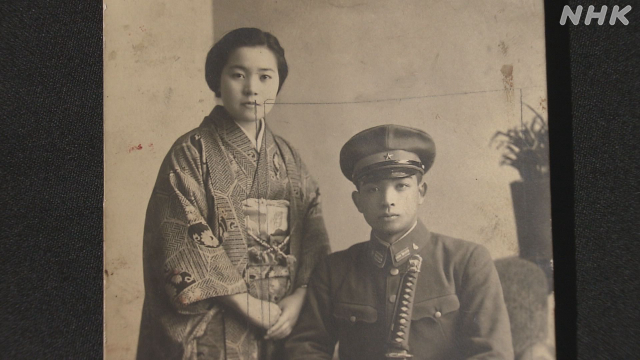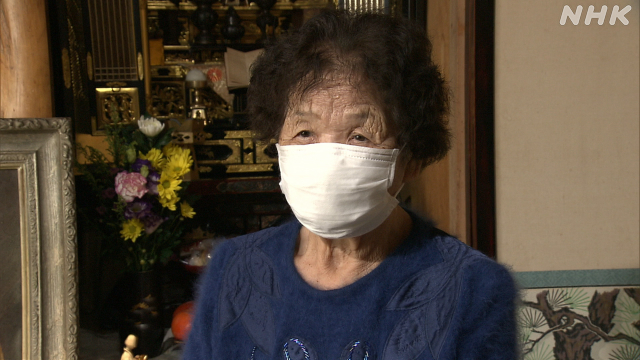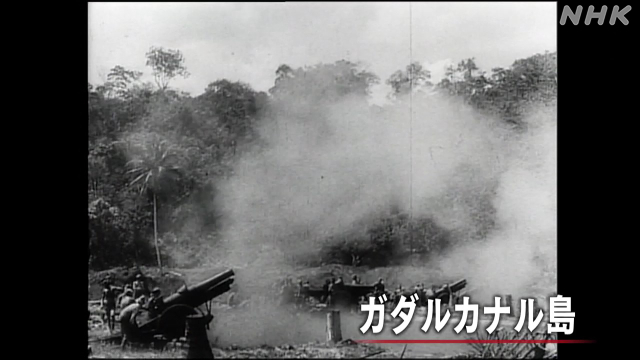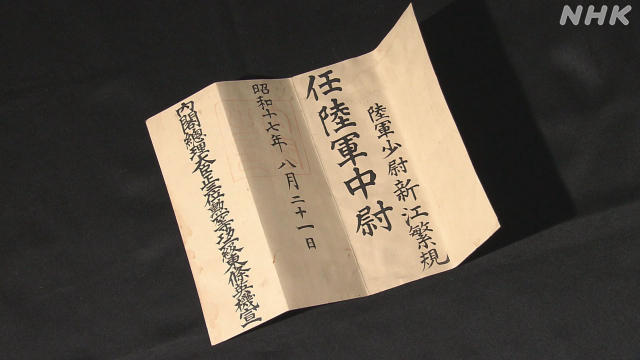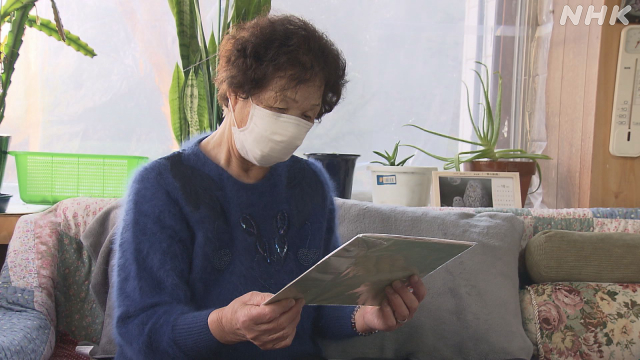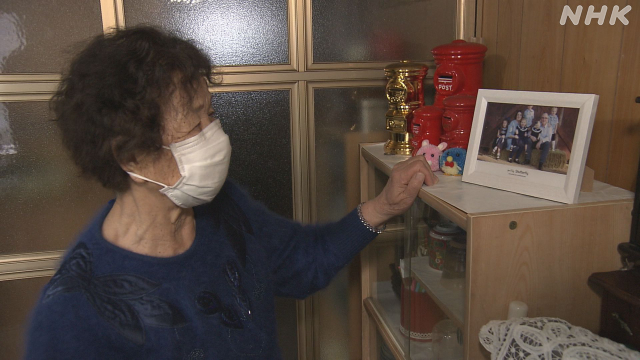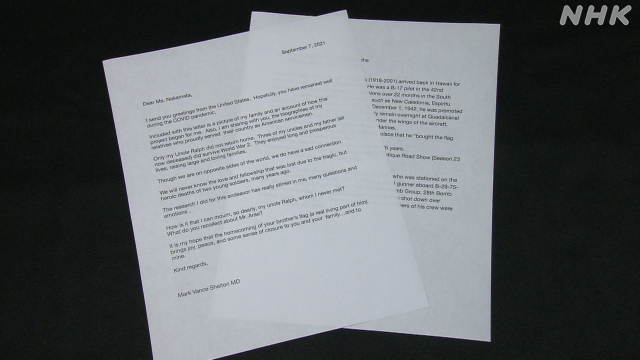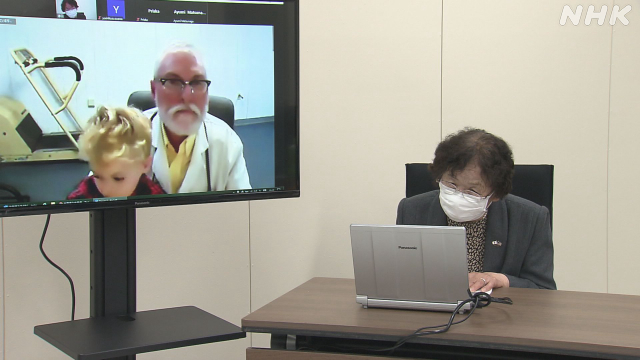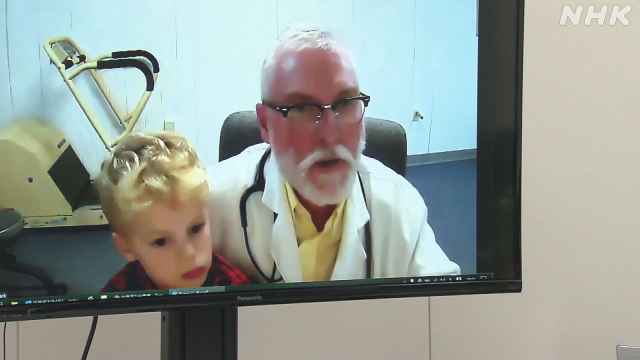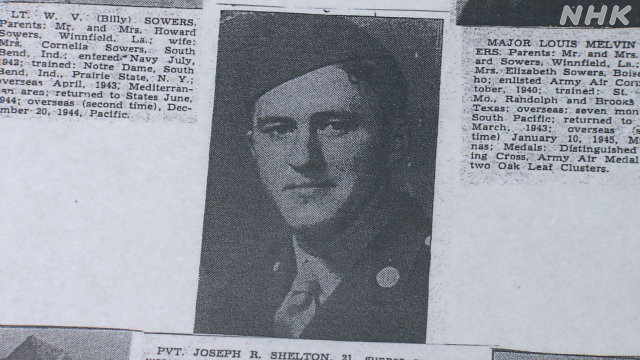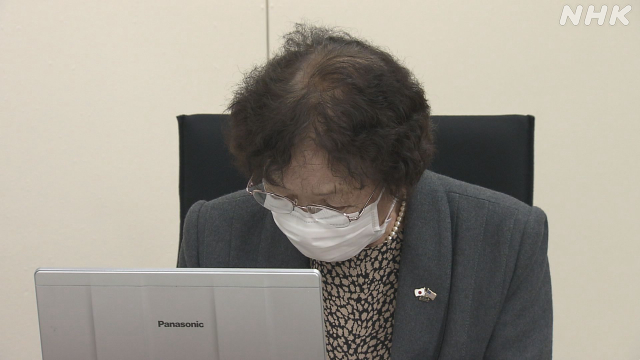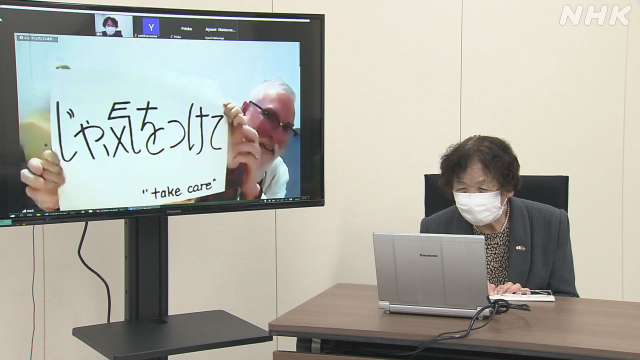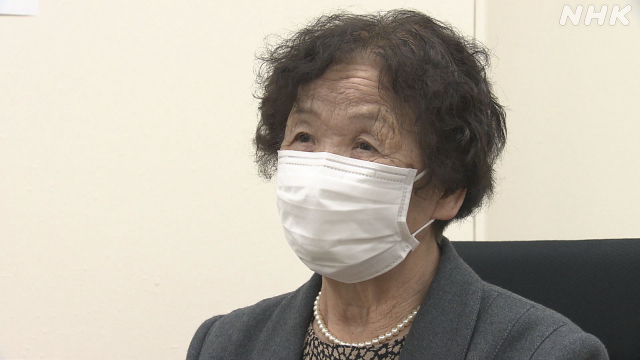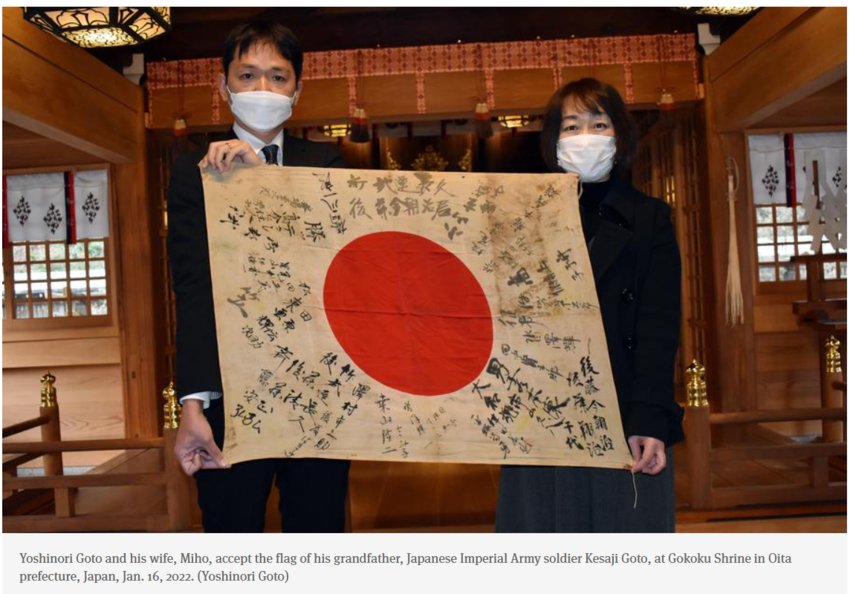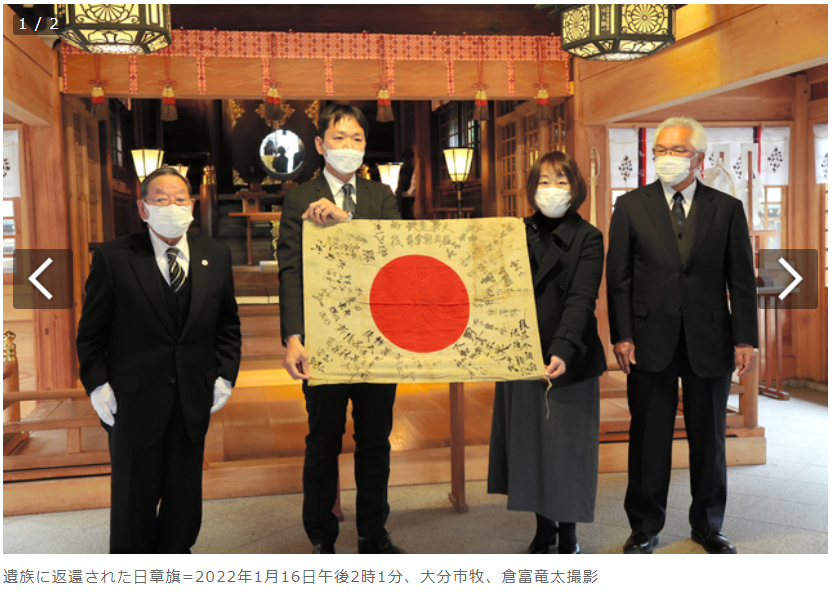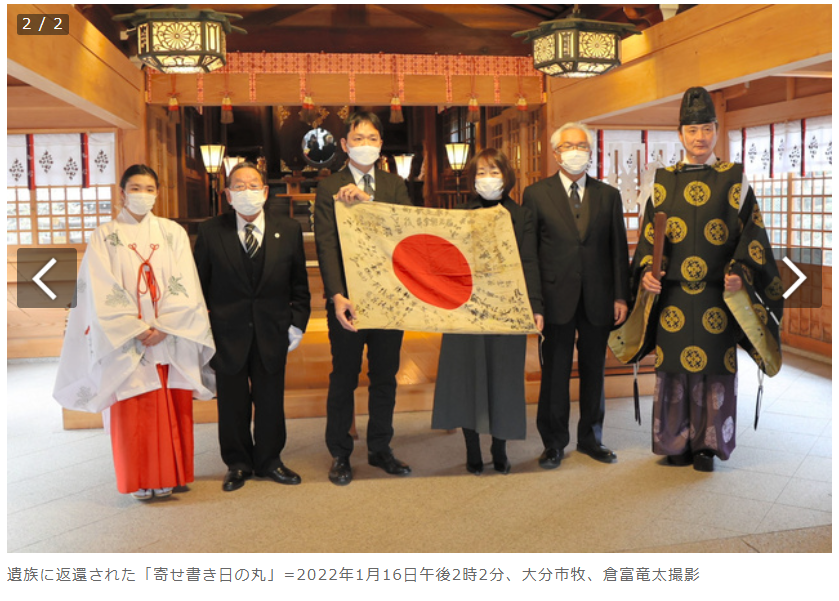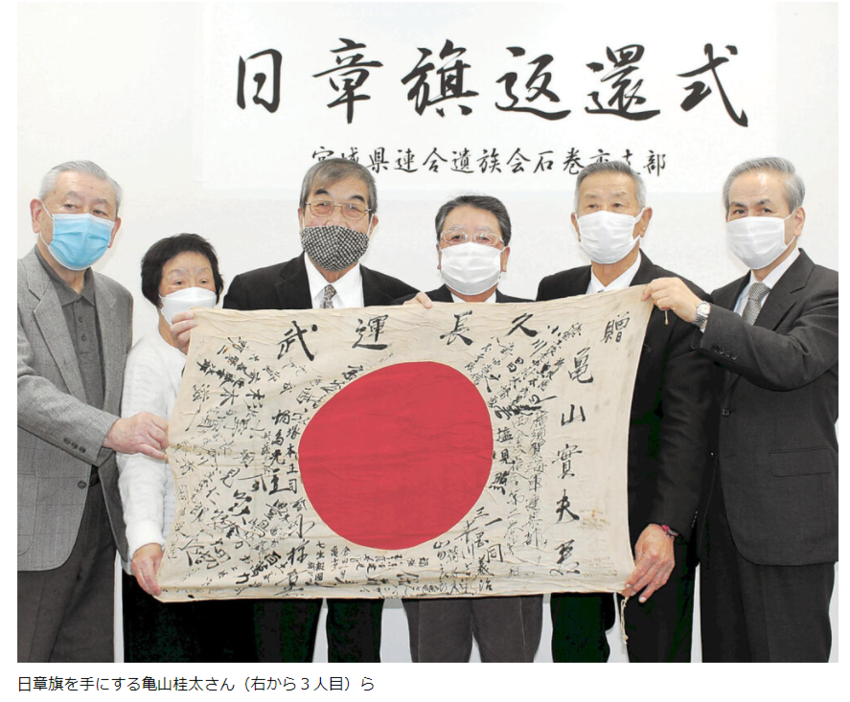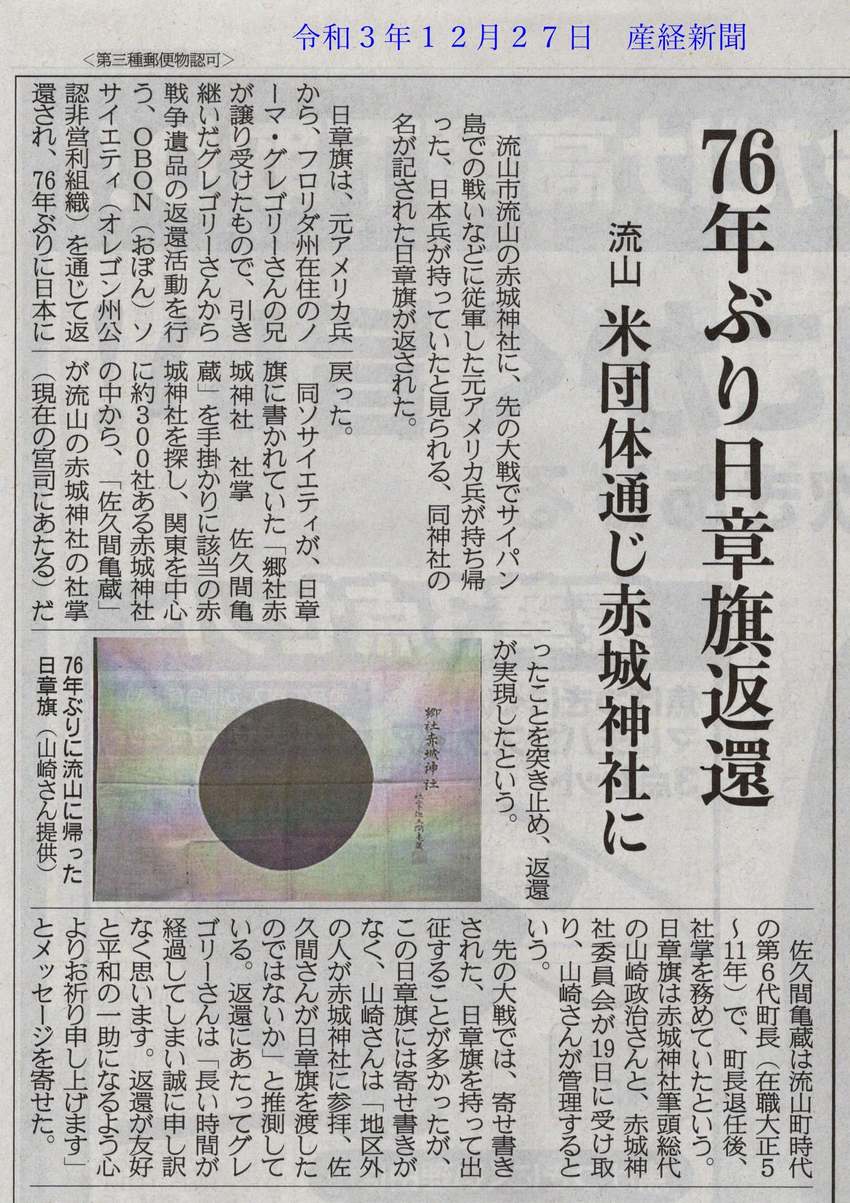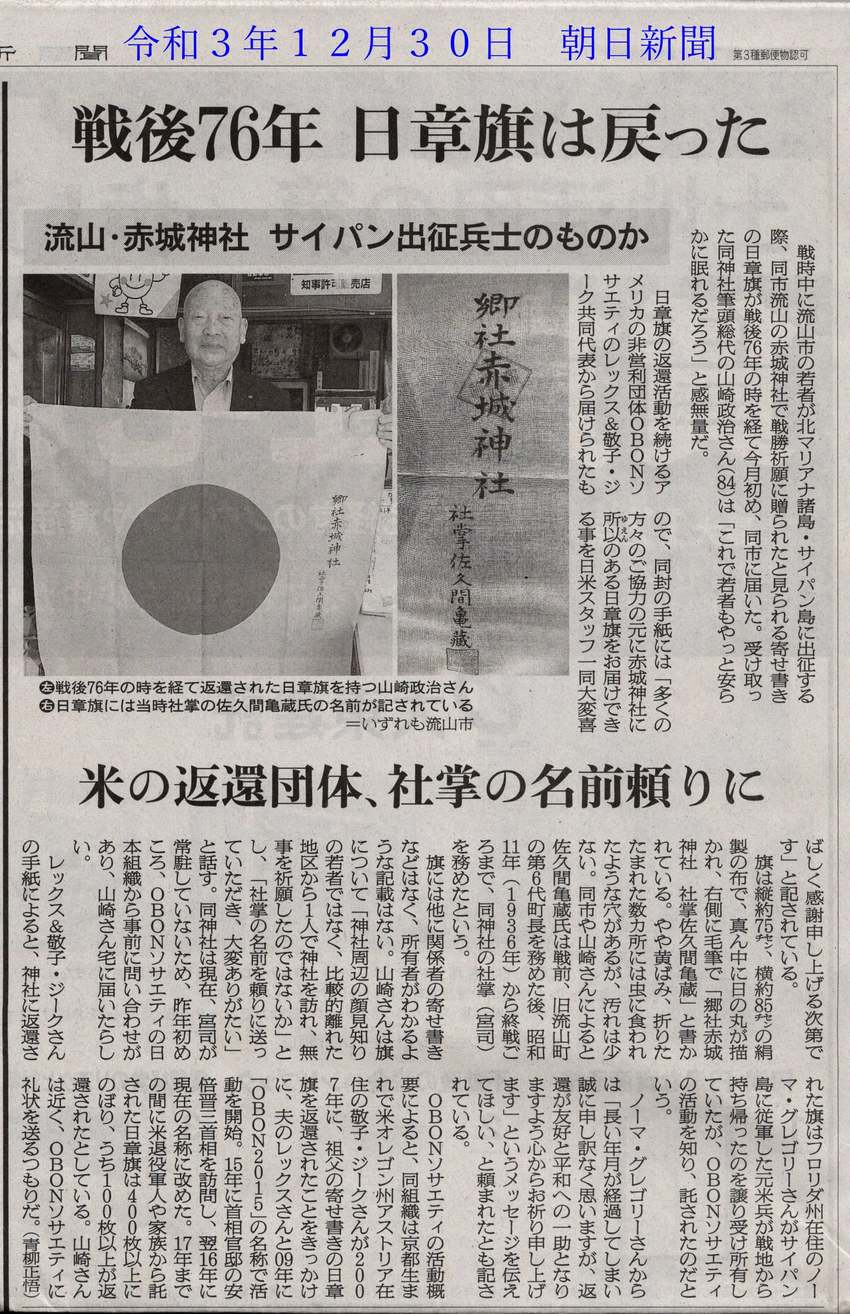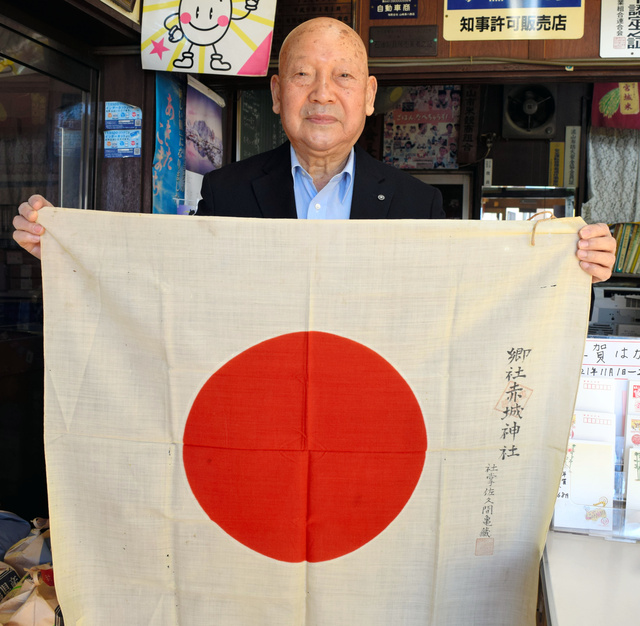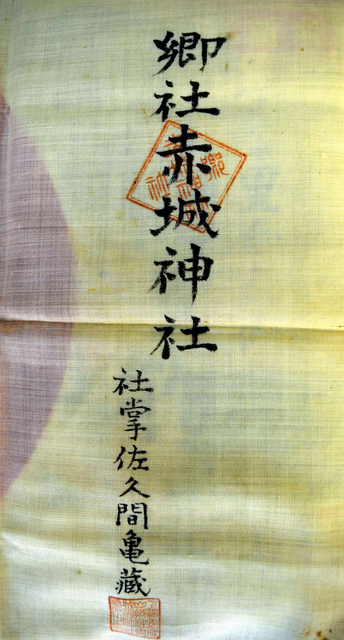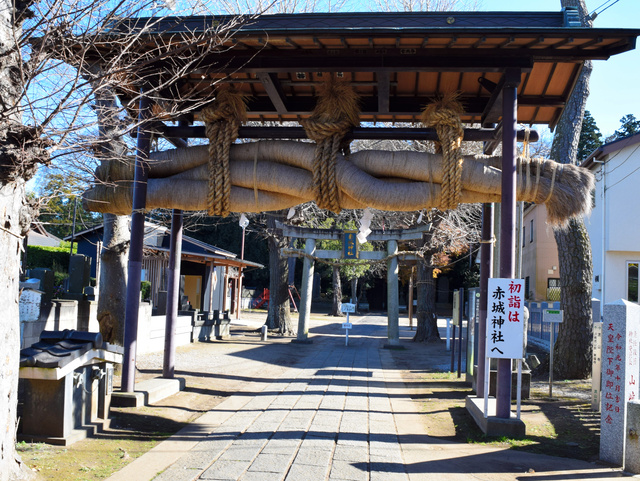- ハッシュタグ「#pacificwar」の検索結果193件
終戦からことしで77年となる中、アメリカ兵が持ち帰った日本兵の遺品が、滋賀県の遺族に返還されました。
家族や友人の思いが書き込まれた日章旗。太平洋戦争で戦地に向かう兵士に託されました。
これらはアメリカ兵が自国に持ち帰っていたもので、アメリカのNPO団体が遺族に返還する活動を続けていて、26日は日章旗3枚が遺族に返されました。
フィリピンのレイテ島で20歳で戦死した大継昇さんの旗は、おいの井上準一さんが受けとりました。
【井上準一さん(71)】
「20歳で亡くなるという戦争の怖さ。ウクライナの戦争で本当にわが身にこう迫ってくるというか。もしまた日本で戦争があったら…もうやめて欲しいという気持ちです」
NPO団体は日章旗などを多く集めていて、持ち主の遺族を探しています。
【動画あり】https://news.yahoo.co.jp/articles/ada659d0f624c75a6441d6c540168ec39cf3b344?fbclid=IwAR1PrXcdIeoP-rxwxIaqCwe8vKfuLLPWDlXNYiLRw7nNJOjjwlU1iA7gfyI
旧日本兵の日章旗、米から遺族のもとへ 大津で返還式
太平洋戦争時に戦地に赴くなどした県内出身の旧日本兵三人の遺品の日章旗が、遺族の元に返還された。二十七日、大津市におの浜のアヤハレークサイドホテルで県遺族会主催の返還式があり、三日月大造知事が遺族三人に日章旗を手渡した。
写真:遺品の日章旗を受け取った遺族ら=大津市におの浜のアヤハレークサイドホテルで
![日章旗の返還を都竹市長(左)に...]() 日章旗の返還を都竹市長(左)に報告した橋詰克也さん(中)ら=飛騨市役所で
日章旗の返還を都竹市長(左)に報告した橋詰克也さん(中)ら=飛騨市役所で
戦死した祖父の遺品、祖国へ 神岡の橋詰さん、米団体から日章旗返還
第二次世界大戦で戦死した、飛騨市神岡町の橋詰運平(かずへい)さんの遺品の日章旗が一月下旬、米国のNPO団体「OBONソサエティ」から、孫にあたる同町の橋詰克也さん(58)の元に返還された。
運平さんは一九一二年生まれで、四四年七月十八日にサイパン島で戦死。運平さんの遺品はなく、長男で克也さんの父の哲雄さんも、四年ほど前に亡くなったという。
遺品の日章旗は、米国人が保管しており、旧日本兵の遺留品返還に取り組む同団体が遺族を探していた。飛騨市遺族連合会を通じて連絡を受けた克也さんが、受け取りを希望して、返還が実現した。返還された旗には「必勝」などの文字とともに、当時の区長や住民らの氏名およそ六十四人分が書かれている。
今月二十五日には、克也さんと市遺族連合会の水谷兼太郎会長代行が市役所を訪れ、都竹淳也市長に経緯を報告。日章旗を見た都竹市長は「八十年近くたっても、戻ってくるのがすごい。(旗から)思いを感じる」と話した。
克也さんは「『こんなことがあるんや』と、信じられない気持ちでいっぱい」と思いを吐露。運平さんの長女・道子さんが現在、愛知県春日井市に住んでいるといい「まず、春日井に送って見てもらい、春になったらお墓参りをしたい」と話した。
https://www.chunichi.co.jp/article/425126

![【STARS AND STRIPES】 Navy vet’s...]()
Navy vet’s daughter returns Japanese flag taken as war trophy from Battle of Okinawa.
TOKYO — A Japanese flag, brought to America by a U.S. Navy sailor from the Battle of Okinawa, has been returned to the family of the soldier who carried it into battle more than three quarters of a century ago.
The signature-covered flag, brought home from the war by James Ellis Mercer, was returned by his daughter Linda Hahn, 72, of Concord, Calif.
Many Japanese soldiers carried the red and white flags inscribed with names and messages from family and friends for good luck.
The flag was accepted by Yoshinori Goto, 45, of Oita city, the grandson of Kesaji Goto, a Japanese Imperial Army soldier who carried the flag and died July 1, 1945, on Okinawa. The ceremony, which Hahn didn’t attend, took place Jan. 16 at the Gokoku Shrine in Oita.
Mercer, a machinist’s mate from Goodland, Kan., served aboard the seaplane tender USS Bering Strait. The warship supported aircraft that rescued dozens of downed airmen and sailors from stricken vessels during the Battle of Okinawa from April to June 1945.
The flag was folded inside an album of war photographs left by Mercer, who died in 2003 at age 83, Hahn said in a telephone interview Wednesday.
The family knew he served on Okinawa but not many other details of his wartime experience.
“He never talked about it,” Hahn said. “I don’t think it was a real happy time for him.”
After the war, Mercer set up a machine shop and worked on heavy vehicles such as forklifts and trucks, she said.
A retired bank employee and mother of one, Hahn contacted the Obon Society in September after hearing about their work from a friend. The nonprofit group helps veterans and their families return old war trophies like flags and swords.
“I thought in my heart that if the situation were reversed and it was my son who was getting something from my father, I would want that,” she said.
The society tracked down Kesaji Goto’s relatives within a couple of months. Goto was from Fujiwara village in Oita prefecture. His name is written on the flag in kanji characters.
“I am thankful that they had kept it until now and even decided to return it,” Yoshinori Goto, an employee of the Oita prefectural government, told Stars and Stripes by phone.
Kesaji Goto died in his early 30s and left behind a wife and 1-year-old son, his grandson said.
The family tomb includes an engraving of Kesaji Goto’s name. So does a monument at the Peace Memorial Park on Okinawa, Yoshinori Goto said.
The family kept a photo of their fallen relative but didn’t talk about him a lot. It was a surprise when the War-Bereaved Families Association contacted them about the flag, he said.
Some Japanese relatives of war dead, citing little or no connection with the original owners, decline to receive returned flags, but Goto had no hesitation accepting it, he said.
The news was “a bolt out of the blue,” he said. “I definitely wanted to receive it.”
The flag includes his father’s name, Shoji Goto, between his grandparents’ names.
“This shows that my father was either born or at least his name was picked when my grandfather went to war,” he said.
The flag’s return gave him a chance to talk about his grandfather with his children, he said.
“I hope people will take an opportunity to think about peace,” Yoshinori Goto said.
Although he had seen a photograph of the flag before receiving it, it felt different touching it, he said. “It tells a story,” he said. “I felt the soul of my grandfather.”
HANA KUSUMOTO - https://www.stripes.com/theaters/asia_pacific/2022-02-03/japanese-flag-return-battle-of-okinawa-us-navy-world-war-ii-4571775.html?fbclid=IwAR1dUu7qKMExYMkOPGvNQ-942W0H0sBxP2GlkzKJWCpC51-HDNxiWbmycwI

![Mainichi Newspaper featured re...]()
WWII soldier's good-luck flag returned from US to grandson in southwest Japan
OITA -- A Japanese flag thought to have been taken to battle by a soldier who died fighting in Okinawa Prefecture during the Pacific War's last days was returned to his grandson in the southwest Japan city of Oita on Jan. 16.
Upon receiving his grandfather's flag over 70 years after the war, Yoshinori Goto, 45, an Oita Prefectural Government employee, renewed his determination for peace, saying, "We have to pass down the horror of war."
According to Yoshinori, his grandfather Kesaji Goto left his village of Fujiwara -- now part of the town of Hiji -- in Oita Prefecture for the front. Kesaji is known to have belonged to the 12th Independent Infantry Battalion of the 44th Independent Mixed Brigade, but details including exactly when he went off to war are reportedly unknown. He is believed to have died in his 30s on July 1, 1945.
On the good-luck flag are messages to Kesaji including the word "Buunchokyu (long-lasting good luck in battle)." It is thought to have been taken to the U.S. by then Marine James Ellis Mercer, and was kept by his daughter Linda Hahn.
The Obon Society, an American nonprofit organization whose activities include returning Japanese flags, inquired with Oita Prefecture's association of war-bereaved families about the flag. Kesaji's family was then identified.
The flag's handover ceremony was held at Gokoku Shrine in Oita Prefecture on Jan. 16. With the flag in his hands, Goto said, "I'd like to say, 'Welcome back,' to my grandfather," and solemnly added that he felt the weight of history.
(Japanese original by Nao Ishii, Oita Bureau)
https://mainichi.jp/english/articles/20220120/p2a/00m/0na/025000c?fbclid=IwAR0YV5UtY0U7GJzqpsoUi8Nhnw5TVraDqscP6tfwYh6PWedClv-QHbi4q-k
沖縄で戦死した祖父の寄せ書き日章旗 遺族のもとへ
第2次大戦中に沖縄本島で戦死した大分県藤原村(現日出町)出身の元日本兵後藤今朝治さんの遺品の日章旗が、遺族のもとに戻ってきた。米兵が米国に持ち帰っていたが、民間団体の仲介で戦後76年たって返ってきた。
孫の辰徳(よしのり)さん(45)=大分市松が丘=によると、今朝治さんは、辰徳さんの父である生後間もない長男を残し、1945年7月1日に沖縄本島で、30代前半で戦死したという。そのため、祖父がどのような人物だったかは、父親から聞かされることもなかった。
日章旗は、今朝治さんが出征する際に家族や身近な人が寄せ書きなどを添えて贈ったものとみられ、祖父や祖母の名前と、生後間もない辰徳さんの父の名前も記されていた。「大和魂」「男子乃本懐」のメッセージと一緒に、多くの人の名前もあった。
日章旗は、米カリフォルニア州のリンダ・ハーンさんが、米兵だった父の遺品として所有していた。戦時中の遺品を遺族のもとに戻す活動をしている米国の「OBONソサエティ」から日本遺族会を通じて調査依頼があり、大分県遺族会連合会や藤原遺族会の協力を得て持ち主が分かった。
16日、大分市の県護国神社であった返還式には、辰徳さんと妻美穂さん(47)が出席。県遺族会連合会の末光秀夫会長が「日章旗は、最期まで肌身につけていた戦没者の魂。家族に会いたいという思いで、返ってきたと思う」と語った。
返還式では、日章旗を保管していたハーンさんのメッセージも披露された。ハーンさんは「この旗があなた方を少しでもお慰めできますよう望んでいる。旗があなた方のもとへ帰っていくことは、私への慰めにもなります」とつづった。
辰徳さんは「きっとこの日章旗は祖父が最期まで、離さず持っていたのでしょう。これを見ると、戦争の悲惨さや平和の大切さを改めて強く思います」と語った。 https://www.asahi.com/articles/ASQ1K725LQ1JTPJB002.html?fbclid=IwAR0zCzJRxn5yZ9xgdisoqCdRnFORimsjNZu_CNEJCPCM01T6NlT1oE_o40g
父の日章旗、息子に返還 石巻の亀山さん
2022年01月07日 10:48
太平洋戦争の激戦地、ガダルカナル島に軍属として参戦した旧稲井村井内の亀山實夫(みつお)さんの日章旗が昨年12月21日、長男の桂太さん(69)=石巻市のぞみ野1丁目=に返還された。亀山さんはガ島でマラリアにかかり日本に帰還、戦死を免れた。桂太さんは「父が生きて帰れたのは日章旗のおかげ」と話した。
日章旗の返還は日本遺族会などを通じて実現した。ガダルカナル島などの戦闘に参戦した元米海兵隊員が持ち帰り、戦没者の遺留品の返品を進める米国のNPO「OBONソサエティ」が保管していた。
石巻市社会福祉協議会であった返還式で、県連合遺族会石巻市支部の鈴木喜美男支部長が「戦争の悲惨さ、平和の尊さを次の世代に語り継いでほしい」とあいさつし、日章旗(横100センチ、縦70センチ)を桂太さんに手渡した。
亀山さんは高校を卒業後、都内の石材問屋に就職。軍属として出征し兵舎の建設に携わったという。出征前に書かれた日章旗には、無事を祈る「武運長久」や、「祈る健闘」などの寄せ書きがある。
マラリアにかかりガ島から生きて日本に戻った亀山さんは戦後、戦争のことはほとんど話をしなかったという。1974年に病気で50歳で亡くなった。
日米開戦から80年の年に父親の日章旗が戻ってきた奇跡に驚く桂太さん。「戦争は駄目。何もいいことがない。これを機会に子ども、孫たちに平和の尊さを語り継いでいきたい」と語った。https://kahoku.news/articles/20220107khn000020.html
【千葉県】昨年の10月に千葉県流山市赤城神社に返還されました日章旗が同年末に神社氏子衆や参拝者に公開されました。県内3新聞社「読売・産経・朝日新聞社」と市の広報誌が取り上げて下さいました。
- ブログルメンバーの方は下記のページからログインをお願いいたします。
ログイン
- まだブログルのメンバーでない方は下記のページから登録をお願いいたします。
新規ユーザー登録へ


